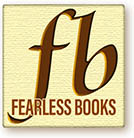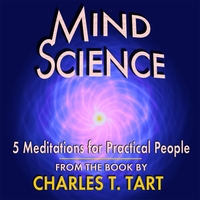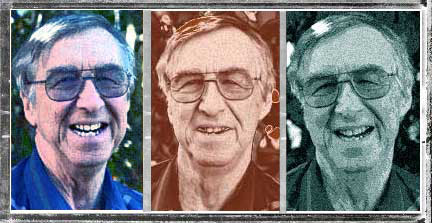
HOME • ASSISTED PUBLISHING • JOIN MAILING LIST
The Classic Practical Guide to Meditation
Fearless Books is pleased to announce a new print edition of MIND SCIENCE: Meditation Training for Practical People by Charles T. Tart, Ph.D., one of the world's leading researchers of consciousness.
The record of a day of meditation instruction with spirited questions from a rationally-minded audience, MIND SCIENCE achieves what most books on meditation rarely do: It's actually fun to read, and it imparts much useful information without religious or mystical overtones. This is a book that's focused on the practical applications of meditation in everyday life, not how to become a rare and special "spiritual" being by way of hours spent sitting motionless on a pillow.
Bringing a great deal of knowledge to bear on the subject while not pretending to be a guru, Dr. Tart tackles real questions that come up in meditation practice, such as: How do you keep your mind from wandering? What do you do about sensations of pain during sitting? How do you deal with too much thinking? and many more. And he answers them with common sense, care, and compassion.
Read an excerpt from the Introduction here.
____________________________________________
CLICK HERE FOR THE mp3 ALBUM OF
CHARLES TART READING 5 GUIDED MEDITATIONS
FROM THE BOOK
_____________________________________________________
As we enter the twenty-first century, too many people are suffering. Much of this suffering is from factors way beyond my ability to affect, but a good deal of it is needless suffering that I can do a little about — suffering that stems from a widespread conflict between science and religion.
On the one hand, we have a science that apparently long ago showed that all religion and spirituality is superstitious and pathological nonsense left over from more primitive times, best thrown out as quickly and thoroughly as possible. On the other hand, we have both traditional religions and “New Age” spiritual movements appealing to something deep within us, but operating in a way often dissociated from scientific knowledge — or with thin and dubious rationalizations such as “Quantum physics is very mysterious, maybe religion is okay after all?” In between are we real human beings who need (psychologically as well as spiritually) a view of reality and our place in it that is much bigger and more meaningful than the apparently scientific, life-as-meaningless-biological-accident view associated with contemporary science, but who can’t simply turn their backs on the great knowledge we’ve gained through science or deny its power.Science gives us power, power to improve the world or destroy it, but gives us no moral guidance on using that power. Spirituality can give us compassion, morality and connectedness, but nineteenth and twentieth century science seems to have undermined spirituality, leaving us with increasing power but no clear morality. We cannot survive in this new millennium if this trend goes on.
I have struggled between these poles of conflict for many years and now reached a stage where I am comfortable with, indeed proud of, calling myself both a rigorous, no-nonsense scientist on the one hand and a spiritual seeker on the other.
Like many of us, I was raised with strong Western religious beliefs — Missouri Synod Lutheran in my case — and, as a child, I basically believed what I was taught. The universe was created by God and existed for His Reasons. Our job (a tough, if not impossible one!) was to avoid sin and be good — or else! But at least life made a kind of sense and the rules were clear.
By the time I was a teenager, reading a lot and thinking for myself, problems arose with this simple faith. I wanted to be “good,” but interpretation of exactly what was good and bad got quite difficult at times, and the behavior of many adults I knew, who professed to be religious, often seemed inconsistent and hypocritical.
I also became more and more fascinated by science, reading voraciously, and the conflict between science and religion became very real for me — as happens for so many of us in modern Western culture. While some scientists of the past saw their work as revealing the glories of God ever more deeply, most scientists today apparently have no use for God or Divine Plans in a scientific world view, and many have claimed and continue to claim that all of religion is primitive, superstitious nonsense that we should leave behind, indeed that religions have vastly increased craziness and suffering in the world. As I now could recognize many examples of pathology in common religious doctrines, practices and ideas, this was a powerful argument.
And yet . . . was religion totally nonsense? Or was there some core of valuable truth hidden down among doctrines, theologies, rituals and customs? I struggled a lot with these kinds of questions in my teenage years.
Many of my contemporaries went through similar struggles, and I suspect many of you have also. As an adult, with the wisdom of hindsight, I was able to see the most common kinds of apparent resolutions people found. One common pattern was for people to become materialists and thus reject religion entirely, as indeed being nothing but total nonsense. This pattern of resolution varied from simple agnosticism at the one extreme to a strong denial of God’s existence in those who became passionate, atheistic materialists. In some of my friends this kind of passion was a reactive anger to disappointment in practicing their childhood religion, a kind of “If God won’t answer my prayers (the way I want them answered) I won’t believe in him!” response, later rationalized as a logical decision to reject religion for lack of evidence.
Another common pattern was one that, as a psychologist, I can retrospectively call mild dissociation or compartmentalization. Religion was put into a mental compartment that was only opened for a few hours on Saturday or Sunday, and that compartment was kept shut the rest of the week so as to not interfere with materialistic, secular life.
Sound familiar?
I was lucky to find a third way which, again with the wisdom of hindsight, I think is a healthier one that involves neither totally ignoring religion nor reactive anger nor the fragmentation of wholeness that’s involved in any kind of dissociative coping strategy. In my extensive reading in many fields of science, in religion, metaphysics, psychology, philosophy and parapsychology, I slowly learned three crucial distinctions, which might be expressed as follows:
Science Does Not Equal Scientism
Spirituality Does Not Equal Religion
Belief Does Not Equal Direct Experience
Science Does Not Equal Scientism
With respect to science, I discovered that because it’s such a valued activity with high social prestige, practically everybody wants to be considered scientific. So we have many outspoken people denying or attacking religion who claim that they are being scientific, but these claims often mask simple human beliefs, arrogance and prejudice that cause people to take quite unscientific positions — something we will occasionally look at in detail in this book. When current scientific theories about the physical world that work well (even if not perfectly) undergo a psychological shift to The Truth, are held with arrogance, and are used as a rationale to attack facts and beliefs that don’t correspond with them, we effectively have a dogmatic religion made of current scientific theories, scientism. This distinction between science and scientism, as sociologists took to calling it back in the 40s (see, e.g., (Bannister 1987) (Schoek and Wiggins 1960) (Wellmuth 1944)), is very important.Spirituality Does Not Equal Religion
With respect to religion, I discovered that there are what we might call primary spiritual experiences, which are the mainsprings powering religion. Religion is a social development that usually started with important, alive, personal spiritual experiences by the founders of the religion. But, too often, the ideas and injunctions supposedly rooted in those experiences have gotten so far from the original spiritual experiences, and gotten so altered by ordinary social and personal needs, as to become a very distorted and pathological system indeed. It’s a long way, for example, from Jesus’ injunction to love one another to the all-too-common “Kill the heathens!” attitude that has too often manifested in our culture.These two discoveries, that science is not the same as scientism and that spirituality is not the same as religion, are hardly unique to me, of course, but since my struggle was affecting me, the personal understanding of these was important to me. Because my struggle between science and religion was similar to that of so many of us today, these distinctions are important to us all.
There is a genuine scientific enterprise, carried out in accordance with the goals and principles of what I like to call essential science, which is discussed in this book, leading to working hypotheses, tentative conclusions, always subject to further test against data, including the data of experience. There is genuine spiritual inquiry which, carried out with humility, a quality usually deemed essential to spiritual development, also leads to working hypotheses, tentative conclusions, always subject to further test against data, including the data of experience. I find these two activities compatible in principle, and, as I mentioned above, can say that I’m comfortable calling myself both a rigorous scientist and a spiritual seeker.
Then there is the “religion” of scientism versus traditional religion, which will always have many conflicts with each other, conflicts often motivated on both sides by fear and anger, insecurity and reaction to childhood disappointments. In both cases what should be tentative working hypotheses/beliefs, the best we can do for the time being but subject, with humility, to further test, become Truths which are defended against perceived Heresy. When people are psychologically and illogically emotionally attached to their beliefs, they will always be threatened by others who don’t share them or question them.
Belief Does Not Equal Direct Experience
Now, why am I saying so much about religion, spirituality and science in a book that focuses on meditation and mindfulness? This brings us to the third distinction I slowly learned, that belief is not the same as direct experience. Our Western religions are generally quite authoritarian. “This is the Truth! Believe it and live by the Rules, or go to Hell! If you doubt, if you question, that’s a sin!” Quite aside from all the nasty psychological consequences this attitude brings about when it’s forced on children or adults, it’s completely incompatible with the basic scientific attitude. This scientific attitude assumes we’re pretty ignorant about the nature of reality, but that we can find out more and more about all of reality through disciplined investigation. It’s an attitude that wants to find out.Meditation and mindfulness practices, as described in my books, are not doctrines or religious “truths,” except in the very minor sense that it’s believed that becoming more mindful will lead to better outcomes in life than being insensitive and ignorant. I think that’s an essential working belief if we are to move on from where we are: after all, if we believe mindfulness won’t help us we won’t try it and, sure enough, it won’t help us — which doesn’t tell us anything. Meditation and mindfulness practices are methods for discovering fundamental truths about yourself and about reality for yourself. Methods for getting more direct knowledge, data, instead of being satisfied with beliefs and theories given you by authorities. Methods that you have to practice and see what happens, not beliefs to hold or reject.
Although there have been Western meditation and mindfulness methods, as rather esoteric parts of Judaism and Christianity, we had pretty much lost meditation and mindfulness practices as a culture until the infusion of workable methods from Eastern cultures, starting in the 60s and continuing through today. This is not to say, of course, that Easterners can’t be as stuck and blinded in religious beliefs as we can. I have been a student (not the best student, by any means, but a pretty serious one) of Eastern spiritual meditation and mindfulness methods for several decades. While I still primarily see myself as a scientist, and certainly not an accomplished meditator or a “mystic,” I have learned enough to be able to teach the basic methods in ways that work for modern Westerners, especially the scientifically trained and inclined. And, given the pervasiveness of science throughout modern, global culture, we are all scientifically inclined, whether we consciously know it or not.
Don’t be discouraged if initially learning meditation and mindfulness in life is hard for you. It’s easy for some people, but it was especially hard for me, with an overly active, overly skeptical mind, yet I eventually learned enough that meditation and mindfulness are some of the most valued parts of my life. If you learn these basic meditation and mindfulness techniques, perhaps you’ll become a better scientist. Perhaps you’ll become a better person. Perhaps you’ll have some spiritual experiences — perhaps you won’t. Perhaps you’ll just become more practical, intelligent and sensitive through a clearer perception of what actually goes on in your own mind and in the world. That’s mainly what’s happened to me, but that’s me, not you. And perhaps . . . who knows what you might learn as you become a more skilled observer of your own mind and self?
But you won’t know unless you give it a good try! Modern science arose as a reaction to the authoritarian attitudes of the Church, which said that if you wanted to know Truth, just read the accepted Scriptures, believe what the approved authorities said. Science claimed the right to go out and actually look at data! The authorities said that the heavier a body was, the faster it fell. Science went out and looked at actual falling bodies and discovered that, once you ruled out air friction in light objects, all bodies fell at the same rate.
We have a lot of opinions, received truths about the mind from authority figures, many of them conditioned into us when we were children but still operating today. The skilled means of meditation and mindfulness in life give us a chance to find out what’s really there for ourselves, and quite “ordinary” people can go a long way — if they learn and try.
As Henry Ford is supposed to have said, “Those who think they can and those who think they can’t are both right.”
Adapted from the Introduction of MIND SCIENCE by permission of the author.
Copyright 2013 by Charles T. Tart. All rights reserved.
Charles T. Tart, Ph.D., is internationally known for his psychological work on the nature of consciousness, particularly altered states of consciousness — as one of the founders of the field of transpersonal psychology — and for his research in parapsychology. His two classic books, "Altered States of Consciousness" (1969) and "Transpersonal Psychologies" (1975), were widely used texts that were instrumental in allowing these areas to become part of modern psychology.
He was a Professor of Psychology at the Davis campus of the University of California for 28 years, where he conducted his research and was a popular teacher. In the 1970s Dr. Tart consulted on the original remote viewing research program at Stanford Research Institute, where some of his parapsychological work was instrumental in influencing government policy makers against the funding of the proposed multi-billion dollar MX missile system.
Besides Altered States of Consciousness (1969) and Transpersonal Psychologies (1975), Dr. Tart's other books are On Being Stoned: A Psychological Study of Marijuana Intoxication (1971); States of Consciousness (1975); Symposium on Consciousness (1975, with co-authors); Learning to Use Extrasensory Perception (1976); Psi: Scientific Studies of the Psychic Realm (1977); Mind at Large: Institute of Electrical and Electronic Engineers Symposia on the Nature of Extrasensory Perception (1979, with H. Puthoff & R. Targ); Waking Up: Overcoming the Obstacles to Human Potential (1986); Open Mind, Discriminating Mind: Reflections on Human Possibilities (1989); Living the Mindful Life (1994) and Body Mind Spirit: Exploring the Parapsychology of Spirituality (1997), which looks at the implications of hard scientific data on psychic abilities as a foundation for believing we have a real spiritual nature. His 2001 book, Mind Science: Meditation Training for Practical People presents mindfulness training in a way that makes sense for science professionals, and his most recent book, The Secret Science of the Soul: How Evidence of the Paranormal is Bringing Science and Spirit Together integrates his work in parapsychology and transpersonal psychology to show that it is reasonable to be both scientific and spiritual in outlook, contrary to the widely believed idea that science shows that there is nothing to spirituality.
He has had more than 200 articles published in professional journals and books, including lead articles in such prestigious scientific journals as Science and Nature.
Not just a laboratory researcher, Dr. Tart has been a student of Aikido (in which he holds a Black Belt), meditation, Gurdjieff's Fourth Way work, and Buddhism. He has been happily married for more than 50 years and has two children and two grandchildren. His primary goal is still to build bridges between the genuinely scientific and genuinely spiritual communities, and to help bring about a refinement and integration of Western and Eastern approaches for knowing the world and for personal and social growth.




